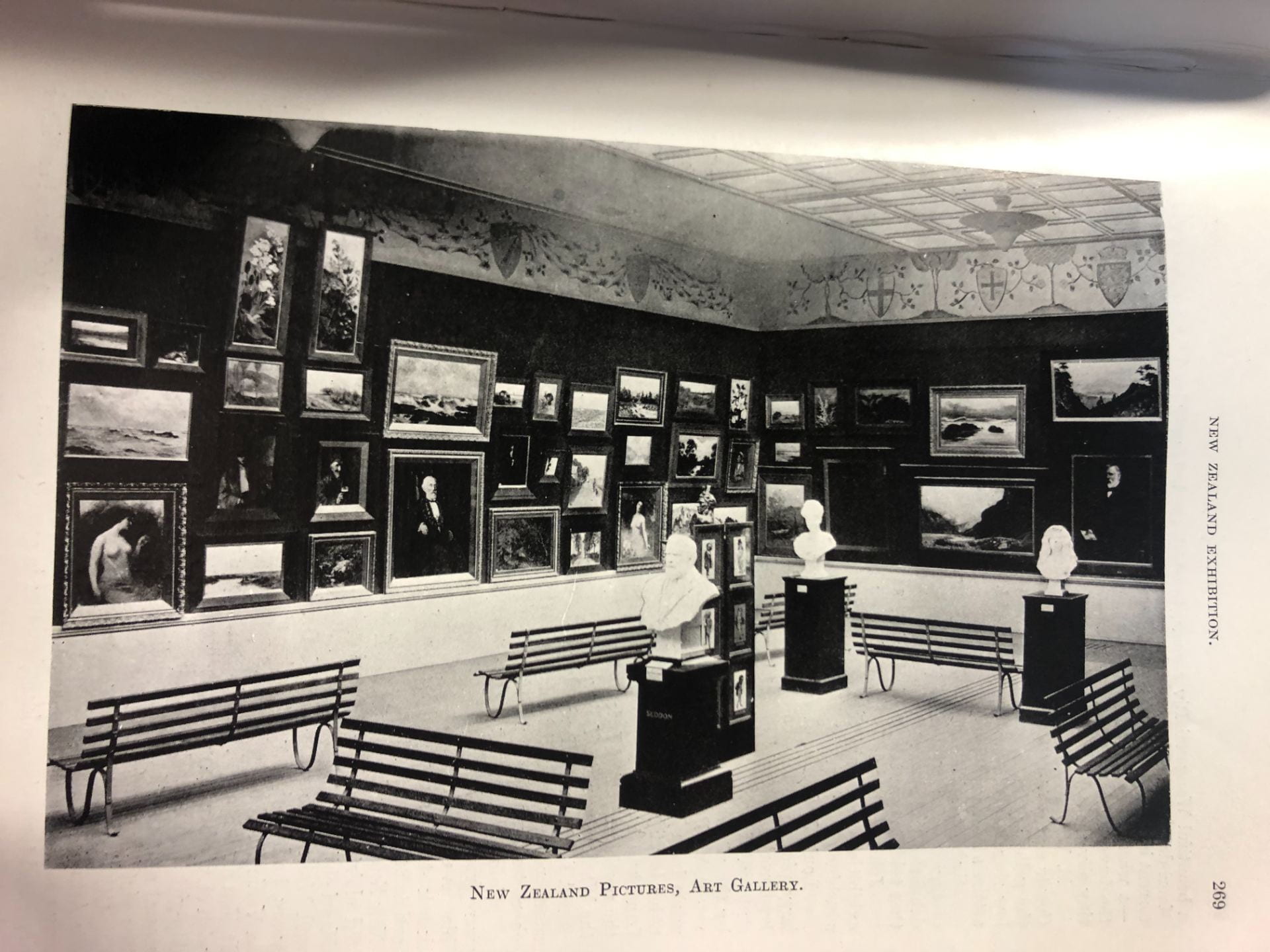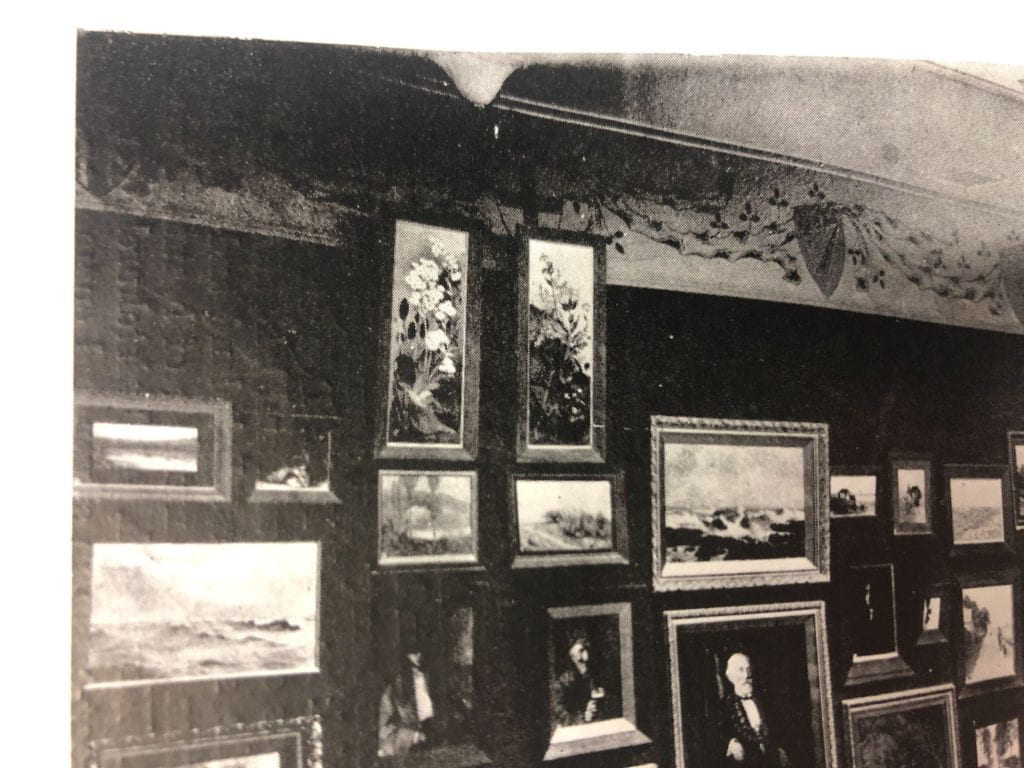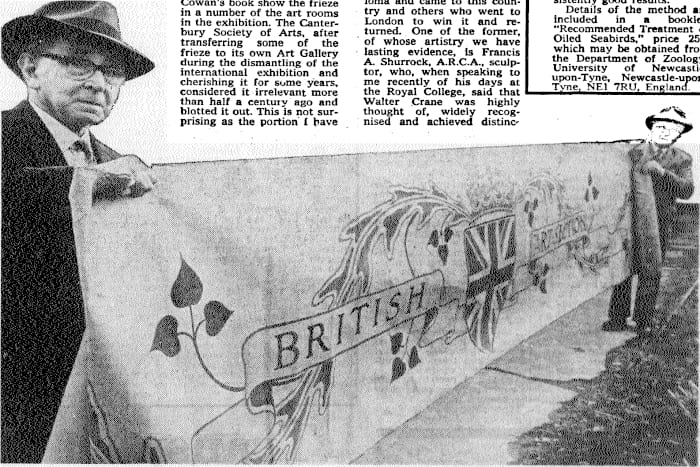By Catherine Field-Dodgson and Michele Leggott
Last month Michele reflected on Emily Harris’s missing 1906 sub-antarctic panel and wondered what it might look like:
We can make some guesses about the size and content of Emily’s second panel of Antarctic flowers, to date unlocated. Given her predilection for symmetry we can guess the second panel will be the same size and shape as the first. Given also that Emily painted six species of Sub-antarctic mega-herbs, we might guess that three more appear in the second panel… Two pleurophyllums and a bulbinella become the focus of our enquiry, suggesting a panel of purples and golds against a rocky coast. (‘Antarctic Flowers 1906 at Puke Ariki,’ 17 July 2023)
With thoughts of sub-antarctic oil paintings planted firmly in our minds, we dived again into the world of the 1906 International Exhibition in Christchurch. We revisited newspaper articles, different catalogues and photographs afresh. Then page 259 of James Cowan’s Official Record caught Catherine’s eye. Stretching across the page was a black and white photograph of the New Zealand art gallery, with paintings hung three and four deep. And there they were blinking at her: two large flower panels hanging side-by-side at the top of the wall in the New Zealand gallery.


Our delight at recognising the panels increased as we realised that the flowers in the ‘missing’ panel could also be identified. Michele’s guesses proved to be more or less correct: in the mid-ground are four darker-coloured Bulbinella flower-heads. To the right of them is a tall stem with lots of pale daisy-like flowers, that are likely to be pleurophyllum, as there is a large leaf underneath them. Together the two panels capture the full spectrum of sub-antarctic plants that Emily painted in watercolour so many years earlier.

We can assume the colours as well as the subject matter and composition contribute to a carefully worked out continuity between the two panels. We can also see that they have been hung in incorrect order on the gallery wall. Emily wrote ‘Panel 1’ and her price (ten guineas) on the back of the Puke Ariki panel, which appears on the right in the photo. Presumably the panel on the left will have ‘Panel 2’ and the same price written on the back. Like its counterpart, the front of Panel 2 will have a series of little roman numerals to designate each plant species depicted there. Hung correctly, the panels make a diptych that is also a nod to the botanical proximity of the big sub-antarctic plants growing together in profusion across the islands.
This photo is the only record that proves Emily’s two sub-antarctic panels were on display in the New Zealand section of the art gallery. They are not listed in the official catalogue for the Fine Art Section, and James Cowan does not mention Emily by name in his Official Record.
A closer look at the photograph reveals that the two panels sit rather awkwardly in the New Zealand gallery. They have been ‘skyed,’ placed high on the wall above three rows of paintings lower down. While the rest of the works in the gallery are hung neatly underneath the decorative frieze that runs around the top of the wall, Emily’s two panels reach up into its splendid wreathing of leaves and vines. They push out of their allotted space, looming over the works below. Their placement in the gallery and absence from official catalogues implies some administrative hitch. We look again at the 1906 timeline.
Emily’s colleagues from the Suter Art Society shipped their paintings for the International Exhibition together, and the works were in Christchurch by 19 September. (Press, 19 Sept 1906: 7) The Nelson artists and their works appear in the Fine Art catalogue. But Emily shipped her paintings 9 October, almost a month after the Suter consignment. (Nelson Evening Mail, 9 Oct 1906: 2) First they travelled by the Penguin to Wellington where they were transferred to another steamer on the regular run between Wellington and Lyttelton. Arriving in Lyttelton, they had to be delivered from the port to the Exhibition buildings in Hagley Park. A transit time of at least three or four days seems likely.
The official responsible for hanging the paintings in the British, Australian and New Zealand sections of the Art Gallery was British Art Commissioner Mr Alfred A. Longden. He had begun hanging paintings by the end of September, and by 13 October newspapers were reporting that ‘Picture-hanging in the art gallery is almost completed’. (Auckland Star, 13 Oct: 6) It would seem that Emily’s panels had to be fitted into a room that was mostly complete by the time they arrived. Big paintings were quite commonly skyed. Longden adjusted his top row and hoisted Emily’s panels aloft.
We become curious about the decorative frieze that the panels bump into at their highest point? The frieze is the work of distinguished British artist and illustrator Walter Crane. It is painted and stencilled on scrim one yard wide and was designed to run around the top of gallery walls in Christchurch. Longden ordered painted scrim for the walls of the galleries to complement the colour and texture of the frieze and was praised for his efforts in the local press:
The ceilings of the Art Gallery are about the height of an ordinary room in a large dwelling, so that none of the exhibits can be ‘skied’ out of sight. No fault can be found with the painting of the walls. The overhead frieze is most beautiful, this being sent out by Mr Walter Crane, and constituting this master’s chief exhibit. The idea was to bring enough of this frieze to top the English pictures, but the Home people, doing everything on a generous scale, had plenty of the frieze to spare, and Mr Longden furnished the Art Gallery throughout. (Evening Star, 9 Nov 1906: 6)
A portion of Walter Crane’s frieze with a remarkable backstory of its own reappeared in Christchurch in 1972. Under the heading ‘Frieze revealed after 50 years obscurity,’ William Baverstock, retired first director of the Robert McDougall Art Gallery, unpacked the history of his fragment of the frieze:
During my term as secretary of the Canterbury Society of Arts from 1943 to 1959, I often glanced aloft in the Armagh Street room of the old Art Gallery. I knew, as few did then and fewer do now, that hidden behind a plain cream covering, and surrounding the entire Wall of the big gallery, was a symbolic frieze designed by one of the best British artist decorators of his day, Walter Crane.
It was, I thought, painted over with cream paint and lost for ever. Not so: it was merely obscured by 80yds of plain cream-painted fabric 3ft wide. As proof of this I now have in my possession a central strip of the frieze itself salvaged during the present work of part-demolition and remodelling of the old Art Gallery for Law Court purposes.
My strip of the frieze, 20ft long by 3ft deep, painted on jute, is by no means a valuable work of art, but it is at least a reminder of adventurous days in Christchurch. It formed a decorative part of the New Zealand International Exhibition of Arts and Industries in Hagley Park, Christchurch, 1906-7, which was indeed an adventure and achievement of some magnitude for a small community (New Zealand’s population was only 965,457) and something never-to-be-forgotten by those of us who, as schoolboys, enjoyed its thrills.
James Cowan, in his official record of the New Zealand International Exhibition, published in 1910 by authority of the Prime Minister, Sir Joseph Ward, describes the frieze in considerable detail of which I will quote only a part:
‘A fine decorative effect was given to the British art rooms (and to the New Zealand and Australian rooms) by a handsome frieze, which was designed and for the most part painted by Mr Walter Crane, president of the Arts and Crafts Exhibition Society. The scheme consisted of a series of shields connected by scrolls of foliage. The Royal shield and the Prince of Wales’s shield formed repeated centres, and were flanked each side, the Royal shield by the Prince’s Feathers and the Three Leopards of England, while the crosses saltire of St Andrew and of St Patrick appeared at each end; bay branches completed the decorations. In all, 15 different shields were introduced, and arranged throughout the various rooms. The same general scheme, varied in detail, especially in the designs of the foliage, was continued in the frieze throughout the galleries. It was partly stencilled and partly painted. Mr Cleobury assisted Mr Walter Crane in the work.’
Photographs in James Cowan’s book show the frieze in a number of the art rooms in the exhibition. The Canterbury Society of Arts, after transferring some of the frieze to its own Art Gallery during the dismantling of the international exhibition and cherishing it for some years, considered it irrelevant more than half a century ago and blotted it out. This is not surprising as the portion I have bears the bold words ‘British Art Section’ on a scroll set on either side of a shield containing the Union Flag surmounted by a crown in gold and flanked by symbolic foliage.
Adding not a little interest to my strip of salvaged frieze is that the artists have chosen it to sign with a drawing of a bird, a crane, enclosed by a finely drawn C (presumably the mark of Crane’s assistant, Cleobury) and the date of execution, 04. The two small V’s on either side of the crane may be Cleobury’s initials? (Press, 29 July 1972: 11)

William Baverstock’s portion of the frieze came to the present-day Christchurch Art Gallery in 1986. And so it is that we can see not only the design but the colouring of the work that was interrupted for a few short months by six tall flowering plants from the sub-antarctic islands of New Zealand:

Fantastic research ladies. I am constantly amazed by your work , Sue Needham
Thanks Sue, we were very excited to find this photo! Ngā mihi, Catherine
How wonderful to have a visual of the missing work!
It would be amazing if it surfaced in someone’s collection now – we’d love to see it ‘up close’.